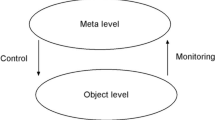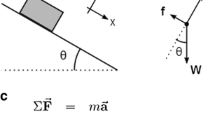Abstract
The purpose of this study was to examine the effects of variations in lesson control and practice on the learning of facts, procedures, and problem-solving skills during interactive video instruction. Subjects were volunteers from graduate and advanced level undergraduate college classes. The instructional content was a 30-minute videotape. “Project Lifesaver,” which was designed to introduce cardiopulmonary resuscitation [CPR]. Students were randomly assigned to one of three instructional control groups: designer control, learner control, and linear control. A posttest was administered to assess learning of facts, procedures, and problem-solving skills. The results indicated that there were [1] significant differences between practiced and non-practiced information; [2] significant differences on posttest scores among various lesson control groups; and [3] a significant interaction between practice and type of learning.
Similar content being viewed by others
References
Allen, W. H. (1957). Research on film use: Student participation.Audio Visual Communication Review, 5, 423–450.
Bidwell, C. M., Collins-Nakai, R. L., Taylor, M. B., & Jensen, W. (1985). Multidisciplinary team production of computer-based simulation to teach pediatrics.Journal of Medical Education, 60, 397–403.
Chu, G. C., & Schramm, W., (1967).Learning from television: What the research says. Washington, DC: National Association of Educational Broadcasters.
Dalton, D. W. (1986). The efficacy of computer-assisted video instruction on rule learning and attitudes.Journal of Computer-Based Instruction, 13, 122–125.
Dalton, D. W., & Hannafin, M. J. (1987). The effects of knowledge-versus context-based design strategies on information and application learning from interactive video.Journal of Computer-Based Instruction, 4, 138–141.
Fitts, P. M., Posner, M. I. (1967).Human performance. Monterey, CA: Brookes Cole.
Hannafin, M. J. (1984). Guidelines for using locus of instructional control in the design of computer-assisted instruction.Journal of Instructional Development, 7, (3), 6–10.
Hannafin, M. J. (1985). Examining the empirical assumptions of computer-based interactive video.Educational Communication and Technology Journal, 33, 235–247.
Hannafin, M. J. (1987). The effects of orienting activities and practice on learning of cued and uncued information.Journal of Educational Research, 81, 48–53.
Hannafin, M. J., Garhart, C., Rieber, L., & Phillips, T. L. (1985). Keeping interactive video in perspective: Tentative guidelines and cautions in the design of interactive video. In E. Miller and M. Mosley (Eds.),Educational media and technology yearbook. Littleton, CO: Libraries Unlimited.
Hannafin, M. J., & Phillips, T. L. (1987). Perspectives in the design of interactive video: Beyond tape versus disc.Journal of Research and Development in Education, 21, 44–60.
Hannafin, M. J., Phillips, T. L., & Tripp, S. D. (1986). The effects of orienting activities, rehearsal, and processing time during interactive video.Journal of Computer-Based Instruction, 13, 134–139.
Harless, W. G. (1986). An interactive videodisc drama: The case of Frank Hall.Journal of Computer-Based Instruction, 13, 113–116.
Heestand, D. (1978). The use of inserted questions in videotape programs.International Journal of Instructional Media, 7, 149–157.
Ho, C. P., Savenye, W., & Haas, N. (1986). The effects of orienting objectives and review on learning from interactive video.Journal of Computer-Based Instruction, 13, 126–129.
Hon, D. (1982). Interactive training in cardiopulmonary resuscitation.Byte, 7(6), 108–138.
Hon, D. (1983). The promise of interactive video.Performance & Instruction Journal, 22(9), 21–23.
Klauer, K. L. (1984). Intentional and incidental learning with instructional texts. A meta-analysis for 1970–1980.American Educational Research Journal, 21, 323–339.
Laurillard, D. M. (1984). Interactive video and the control of learning.Educational Technology, 24 (6), 7–15.
Levenson, P. M. (1983). Interactive video: a new dimension in health education.Health Education, 14 (6), 36–38.
Malouf, D. B., MacArthur, C. A., & Radin, S. (1986). Using interactive videotape-based instruction to teach on-the-job social skills to handicapped adolescents.Journal of Computer-Based Instruction, 13, 130–133.
Merrill, M. D. (1975). Learner control: Beyond aptitude-treatment interactions.Audio-Visual Communications Review, 23, 217–226.
Merrill, M. D., Schneider, E. W., & Fletcher, K. A. (1980).TICCIT, New Jersey: Educational Technology Publications.
Phillips, T. L., Hannafin, M. J., & Tripp, S. M. (in press). The effects of practice and orienting activities on learning from interactive video.Educational Communication and Technology.
Rosenblatt, A. A., & Gaponoff, M. (1984). The microcomputer as a vehicle for continuing medical education.Journal of Family Practice, 18, 629–632.
Ross, S. M., & Rakow, E. A. (1981). Learner control versus program control as adaptive strategies for selection of instructional support on math rules.Journal of Educational Psychology, 73, 745–753.
Salisbury, D., Richards, B., & Klein, J. (1986). Designing practice: A review of prescriptions and recommendations from instructional design theories.Journal of Instructional Development, 8, (4), 9–19.
Schaffer, L. C. & Hannafin, M. J. (1986). The effects of progressively enriched interactivity on learning from interactive video.Educational Communication and Technology Journal,34, 89–96.
Smith, S. G., Jones, L. L., & Waugh, M. L. (1986). The effects of the interactive video on laboratory and pre-laboratory chemistry instruction.Journal of Computer-Based Instruction, 13, 117–121.
Steinberg, E. (1977). Review of student control in computer-assisted instruction.Journal of Computer-Based Instruction, 3, 84–90.
Tennyson, R. D. (1980). Instructional control strategies and content structure as design variables in concept acquisition using computer-based instruction.Journal of Educational Psychology, 72, 525–532.
Tennyson, R. D. (1984). Artificial intelligence methods in computer-based instructional design: The Minnesota Adaptive Instructional System.Journal of Instructional Development, 3, 17–22.
Tennyson, R. D., Christensen, D. L., & Park, S. I. (1984). The Minnesota Adaptive Instructional System: An intelligent CBI system.Journal of Computer-Based Instruction, 11, 2–13.
Author information
Authors and Affiliations
Rights and permissions
About this article
Cite this article
Hannafin, M.J., Colamaio, M.A.E. The effects of variations in lesson control and practice on learning from interactive video. ECTJ 35, 203–212 (1987). https://doi.org/10.1007/BF02766965
Issue Date:
DOI: https://doi.org/10.1007/BF02766965




